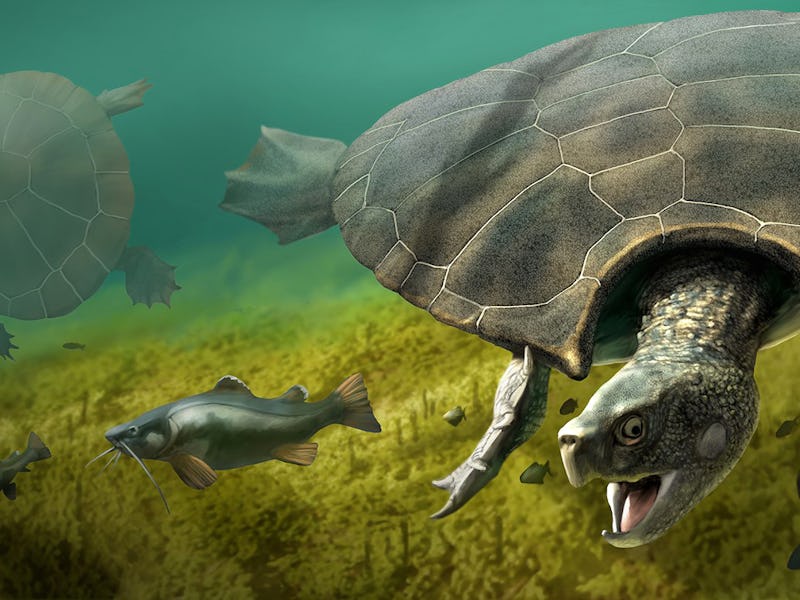Badass prehistoric turtle used its shell in combat
Life during this gnarly time in Earth's history called for some serious protection — even for turtles.

Move over, Teenage Mutant Ninja Turtles — there is a new, shell-backed badass in town.
In a study published Wednesday in the journal Science Advances, researchers announced the discovery of a fossilized prehistoric, metal-AF turtle that roamed the Earth millions of years ago. And from their findings, we can now conclude that this creature was truly wild.
Meet Stupendemys geographicus, a massive turtle with a horned shell measuring about 10 feet across. In its time — between 5 and 23 million years ago — the gigantic beast was more than 100 times heavier than its closest relatives.
The study stems from a rare discovery: The full shell of one of these giant turtles, unearthed in Colombia’s Tatacoa Desert.
In the paper, scientists describe how this turtle used its horned shell — think pointy, dangerous shoulder pads — to its deadly advantage.
Scientists first discovered the remains of Stupendemys geographicus in Venezuela in 1976. But while we have known about the turtle's existence for a long time, scientists were missing a key point of information — a complete shell. And a massive one at that.
Artistic rendering of the giant, prehistoric turtle Stupendemys geographicus.
A deadly giant
So how did this turtle get so big? The turtle's size may be to do with warm lakes and wetlands of the time period, the researchers suggest. The damp environment may have been an ideal climate for the creatures to expand their size, they say.
Other animals from the late Miocene, the time period the turtle dates to, were similarly able to get massive thanks to the climate conditions. Take the prehistoric, 40-foot-long snake Titanoboa cerrejonensis, for example.
As for the turtles, they also didn't have much competition — research suggests that Stupendemys geographicus was the only species of its kind in the northern Neotropic region.
Colombian paleontologist Edwin Cadena, taking notes from one of the male specimens of Stupendemys geographicus during fieldwork in 2016.
All that adds up to what might have been the largest turtle to have ever lived — and probably the most badass... at least until Donatello and Michelangelo came along.
Things were pretty weird on Earth during the late Miocene (did we mention the 40-foot-long snake?). As a result, even turtles needed all the protection they can get — that is where the shell-horns come in. Male turtles may have used this feature as a weapon against other males, helping to protect their skulls, the researchers say. Researchers have uncovered shells with and without the horned protrusions, suggesting that this turtle was sexually dimorphic — meaning males had the horns while females were not so blessed.
It was not just other turtles threatening them: Crocodiles were afoot, too — and looking for a fight. Researchers have found crocodile-bite marks on other turtle specimens from the period. They have even discovered a crocodile tooth lodged in a shell. Ouch.
Abstract: Despite being among the largest turtles that ever lived, the biology and systematics of Stupendemys geographicus remain largely unknown because of scant, fragmentary finds. We describe exceptional specimens and new localities of S. geographicus from the Miocene of Venezuela and Colombia. We document the largest shell reported for any extant or extinct turtle, with a carapace length of 2.40 m and estimated mass of 1.145 kg, almost 100 times the size of its closest living relative, the Amazon river turtle Peltocephalus dumerilianus, and twice that of the largest extant turtle, the marine leatherback Dermochelys coriacea. The new specimens greatly increase knowledge of the biology and evolution of this iconic species. Our findings suggest the existence of a single giant turtle species across the northern Neotropics, but with two shell morphotypes, suggestive of sexual dimorphism. Bite marks and punctured bones indicate interactions with large caimans that also inhabited the northern Neotropics.